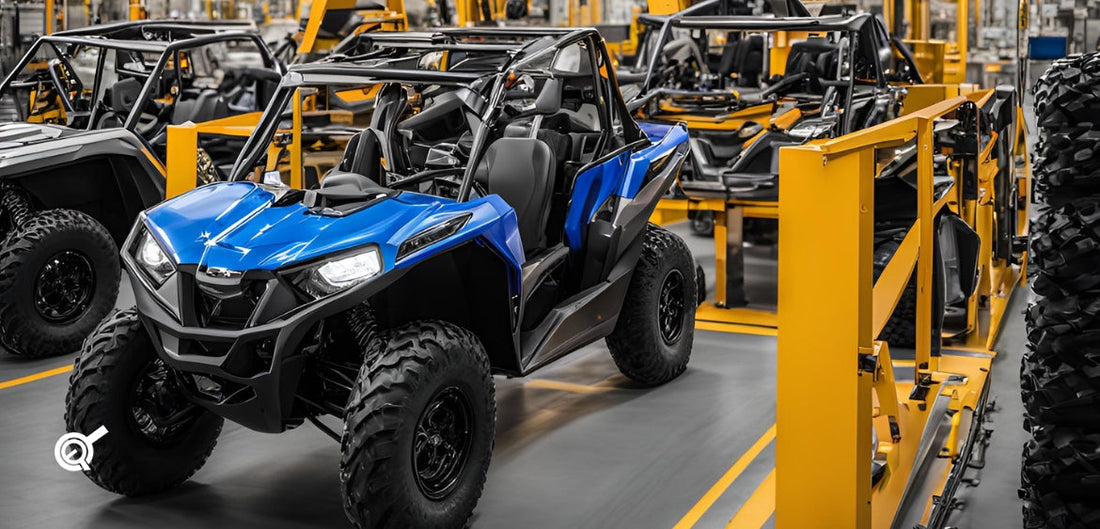En el mundo en constante evolución de la ingeniería automotriz, los avances en la tecnología de actuadores se han convertido en una fuerza clave para transformar el diseño y los procesos de fabricación de los Utility Task Vehicles (UTV) y los All-Terrain Vehicles (ATV). Esta revolución está impulsando mejoras significativas en la experiencia del usuario y redefiniendo las prácticas del sector, haciendo que los UTV y los ATV sean más eficientes, fiables y agradables para los usuarios finales.
En este artículo, analizaremos los avances tecnológicos, los impactos en la fabricación, las mejoras de rendimiento y las tendencias de mercado que actualmente están dando forma al futuro del diseño de UTV y ATV.

Avances tecnológicos
Tecnología de actuadores y materiales ligeros
¿Cómo puede la tecnología de actuadores avanzada transformar la manera en que conducimos UTV y ATV? Uno de los desarrollos más destacados es la adopción de la dirección asistida eléctrica, que ofrece un control preciso y reduce la fatiga del conductor. Esta tecnología sustituye a los sistemas hidráulicos tradicionales, proporcionando una dirección más suave y sensible. La eliminación del fluido hidráulico también reduce los requisitos de mantenimiento y el impacto ambiental.
El uso de materiales ligeros es otro salto tecnológico, y aquí te contamos cómo cambiarían tu enfoque del diseño de vehículos. Materiales como la fibra de carbono y los compuestos avanzados se están empleando para reducir el peso total de los UTV y ATV.

Compuestos de fibra de carbono
Esta reducción de peso mejora la eficiencia de combustible, la aceleración y el manejo, haciendo los vehículos más ágiles y receptivos. Además, estos materiales suelen ser más resistentes que los metales tradicionales, aumentando la durabilidad y la seguridad de los vehículos. Imagina un vehículo no solo más ligero, sino también más resistente y eficiente.

Acero avanzado de alta resistencia
Tecnologías de baterías y suspensión
Otra área crítica de avance son las tecnologías de baterías. La transición hacia modelos eléctricos e híbridos exige baterías no solo más potentes, sino también más duraderas y eficientes. Innovaciones como las baterías de estado sólido permiten recorridos más largos y cargas más rápidas, abordando una de las principales preocupaciones de los usuarios de vehículos eléctricos. Estas baterías avanzadas también son más seguras, reduciendo el riesgo de sobrecalentamiento e incendios.

Tecnologías de suspensión también han experimentado mejoras significativas. Las suspensiones modernas están diseñadas para proporcionar mayor estabilidad y confort en terrenos variados. Los sistemas de suspensión mejorados, como los amortiguadores adaptativos, se ajustan automáticamente a las condiciones cambiantes del camino, absorbiendo los impactos con mayor eficacia. Esto se traduce en una conducción más suave, menos desgaste del vehículo y un mejor manejo general.

Integración de telemática y sistemas de control inteligente
Integración de telemática está revolucionando la forma en que se supervisan y gestionan los vehículos UTV y ATV. Al incorporar telemática, los fabricantes pueden ofrecer datos en tiempo real sobre el rendimiento del vehículo, su ubicación y necesidades de mantenimiento, mejorando así la experiencia del usuario y prolongando la vida útil del vehículo. Además, los gestores de flotas pueden monitorizar el estado de múltiples vehículos de forma remota, optimizando el uso y los planes de mantenimiento para reducir tiempos de inactividad y costos.
Por último, los sistemas de control inteligente están aportando un nuevo nivel de automatización y personalización del usuario a los UTV y ATV. Estos sistemas permiten realizar ajustes automáticos en respuesta a las condiciones de conducción, brindando una experiencia optimizada y garantizando los más altos niveles de rendimiento y seguridad. Funciones como el control electrónico de estabilidad, el control de tracción y los modos de conducción personalizables se están convirtiendo en estándar, ofreciendo a los conductores un mejor control y mayor seguridad.

Impacto en los procesos de fabricación
Los avances en la tecnología de actuadores y otras tecnologías asociadas no solo están mejorando los propios vehículos, sino que también están revolucionando los procesos de fabricación. La ingeniería de precisión está en el corazón de estos avances, permitiendo producir componentes más confiables y de alta calidad. Las técnicas avanzadas de mecanizado y el diseño asistido por computadora (CAD) garantizan que las piezas se fabriquen con especificaciones exactas, reduciendo la probabilidad de defectos y mejorando la calidad general del producto.
Tecnologías de automatización
Automatización en la fabricación es cada vez más común, impulsada por la necesidad de eficiencia y consistencia. Los sistemas robóticos y las líneas de producción automatizadas permiten a los fabricantes producir vehículos más rápido y con mayor precisión, reduciendo el error humano y los costos de producción. Los robots pueden realizar tareas repetitivas con alta precisión, como soldadura, pintura y ensamblaje, asegurando una calidad consistente en todas las unidades.

En Progressive Automations, fabricamos actuadores electromecánicos de alta fuerza diseñados para una amplia gama de aplicaciones de automatización en fábricas automotrices, como pistolas de soldadura robóticas y equipos de mandrinado y bruñido. Nuestros actuadores lineales cuentan con lubricación interna y no requieren mantenimiento, ofreciendo una vida útil más larga en comparación con los sistemas hidráulicos o neumáticos. Además, las soluciones de Progressive Automations se están integrando en las líneas de ensamblaje, proporcionando automatización personalizable y escalable que puede adaptarse a las necesidades específicas de la fabricación de UTV y ATV. Estas soluciones ayudan a reducir el tiempo de producción y mejorar la consistencia del resultado.
Fabricación esbelta y control de calidad
Técnicas de fabricación esbelta (lean) están siendo adoptadas para agilizar los procesos de producción y eliminar desperdicios. Al centrarse en la mejora continua y la eficiencia, los fabricantes pueden producir productos de mayor calidad a un menor costo, algo crucial en un mercado competitivo. Técnicas como la gestión de inventario justo a tiempo (JIT) y Kaizen están ayudando a las empresas a reducir los plazos de entrega y aumentar la flexibilidad de producción.
Innovaciones en control de calidad garantizan que cada vehículo cumpla con los más altos estándares antes de salir de fábrica. Tecnologías avanzadas de prueba e inspección, como la inspección óptica automatizada (AOI) y los ensayos no destructivos (NDT), se utilizan para identificar y corregir defectos en las primeras etapas del proceso de producción, asegurando que solo los mejores productos lleguen al mercado. Además, también se aplican algoritmos de aprendizaje automático al mantenimiento predictivo, identificando posibles problemas antes de que provoquen costosos tiempos de inactividad.
Mejorando el rendimiento y la eficiencia
Los últimos avances en tecnología de actuadores están desempeñando un papel fundamental para mejorar el rendimiento y la eficiencia de los UTV y ATV.
Optimización del motor y gestión de potencia
Optimización del motor es una de las áreas principales de enfoque, ya que los actuadores modernos permiten un control más preciso de los componentes del motor, lo que se traduce en mejor rendimiento y mayor eficiencia de combustible. La distribución variable (VVT) y la inyección directa de combustible son ejemplos de tecnologías que están optimizando el rendimiento del motor.

Gestión de potencia también ha experimentado mejoras significativas. Estos sistemas garantizan que la potencia generada por el motor se utilice de la manera más efectiva, ya sea para mover el vehículo o alimentar sistemas auxiliares. Una mejor gestión de potencia conduce a una mayor eficiencia de combustible y a una mayor vida útil de la batería en los modelos eléctricos. También se están implementando sistemas de frenado regenerativo, que capturan la energía que de otro modo se perdería durante el frenado y la utilizan para recargar la batería.
Aerodinámica y disipación de calor
Aerodinámica es otro aspecto crucial que se ha mejorado significativamente. Al diseñar vehículos con mejores perfiles aerodinámicos, los fabricantes pueden reducir la resistencia y mejorar la eficiencia de combustible. Las mejoras aerodinámicas también contribuyen a un mejor manejo y estabilidad, especialmente a velocidades más altas. Se utilizan técnicas como la dinámica de fluidos computacional (CFD) para optimizar las formas de los vehículos y reducir la resistencia del aire.
Disipación de calor es crítica para mantener el rendimiento y la longevidad de los UTV y ATV. Se están utilizando sistemas y materiales avanzados de refrigeración que disipan el calor de forma más efectiva para evitar el sobrecalentamiento y asegurar un rendimiento óptimo incluso en condiciones exigentes. Se integran disipadores de calor, materiales de interfaz térmica y sistemas de refrigeración activa en los diseños de los vehículos.
Impacto en el mercado y tendencias futuras
El impacto de los avances en la tecnología de actuadores en el mercado de UTV y ATV es profundo. A medida que estas tecnologías se vuelven más comunes, el mercado está experimentando un crecimiento significativo. Las proyecciones apuntan a un aumento sólido de la demanda de UTV y ATV avanzados, impulsado por el mejor rendimiento, la eficiencia y la experiencia de usuario que ofrecen estas nuevas tecnologías. Los analistas prevén un crecimiento continuo tanto en los segmentos recreativos como comerciales, con una adopción creciente de modelos eléctricos e híbridos.

Hablando de las tendencias de la demanda del consumidor, estas están cambiando hacia vehículos más sostenibles y de alto rendimiento. A medida que las preocupaciones ambientales cobran mayor relevancia, los consumidores buscan cada vez más vehículos que ofrezcan un gran rendimiento minimizando su impacto ambiental. Esta tendencia está llevando a los fabricantes a innovar y adoptar prácticas y materiales más sostenibles. Se espera que la demanda de UTV y ATV eléctricos e híbridos aumente, impulsada por incentivos gubernamentales y una creciente conciencia ambiental.
Las tendencias de sostenibilidad también están dando forma al futuro del mercado de UTV y ATV. Los fabricantes se están enfocando cada vez más en producir vehículos que no solo ofrezcan alto rendimiento, sino que también sean respetuosos con el medio ambiente. Esto incluye el uso de materiales reciclables, procesos de producción eficientes y vehículos que generen menos emisiones. Las empresas también están explorando el uso de fuentes de energía renovable en sus instalaciones de fabricación.
Por último, se espera que tecnologías emergentes como la inteligencia artificial (IA) y el aprendizaje automático (ML) desempeñen un papel significativo en el futuro del diseño de UTV y ATV. Estas tecnologías pueden utilizarse para desarrollar vehículos más inteligentes y adaptativos que aprendan de su entorno y optimicen su rendimiento en consecuencia. El mantenimiento predictivo impulsado por IA, los sistemas mejorados de asistencia al conductor y las experiencias de conducción personalizadas son algunas de las posibles aplicaciones.
Conclusión
Los avances en la tecnología de actuadores están transformando la industria de UTV y ATV, impulsando mejoras significativas en el diseño, la fabricación, el rendimiento y la dinámica del mercado. A medida que estas tecnologías continúen evolucionando, prometen ofrecer beneficios aún mayores, haciendo que los UTV y ATV sean más eficientes, fiables y agradables para los usuarios.
En Progressive Automations, nuestros ingenieros siguen de cerca los desarrollos en la industria de UTV y ATV, mejorando constantemente los productos de la empresa para cumplir y superar los altos estándares del sector. Esta dedicación a la innovación garantiza que nuestras soluciones se mantengan a la vanguardia del mercado. Explora nuestra gama de actuadores electromecánicos de alta fuerza y descubre cómo nuestras soluciones pueden revolucionar tus diseños de UTV y ATV. Visita nuestro sitio web.
***
Recursos
- SAE International: Artículos y documentos sobre dirección asistida eléctrica, tecnologías de baterías y optimización del motor. Sitio web: sae.org
- MarketsandMarkets: Informes de investigación de mercado sobre tendencias y proyecciones de la industria de UTV y ATV. Sitio web: marketsandmarkets.com
- IEEE Xplore: Artículos de investigación sobre tecnologías de suspensión y materiales ligeros. Sitio web: ieeexplore.ieee.org
- ScienceDirect: Artículos técnicos sobre técnicas avanzadas de fabricación y automatización. Sitio web: sciencedirect.com
- MotorTrend: Noticias sobre integración de telemática y sistemas de control inteligente en el diseño automotriz. Sitio web: motortrend.com
- Off-Road.com: Noticias y tendencias del sector sobre UTV y ATV. Sitio web: off-road.com
- Grand View Research: Informes del sector sobre tendencias en tecnologías de actuadores y su impacto en el mercado automotriz. Sitio web: https://www.grandviewresearch.com/




